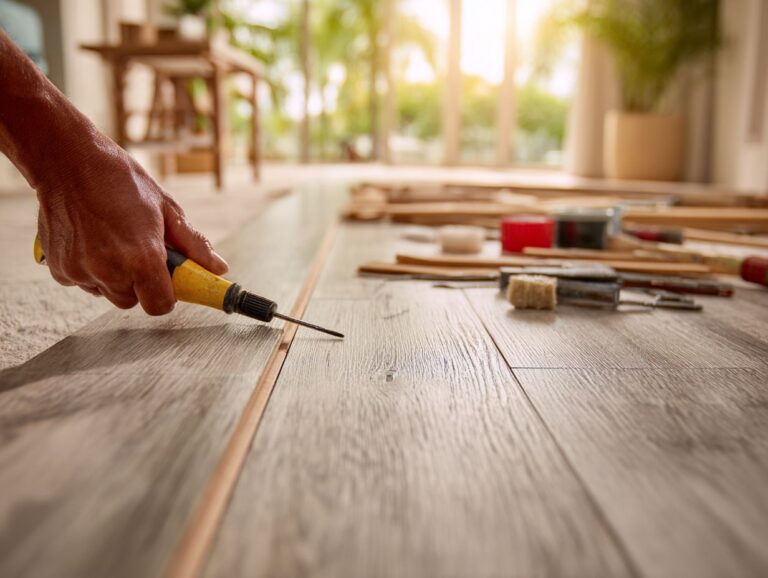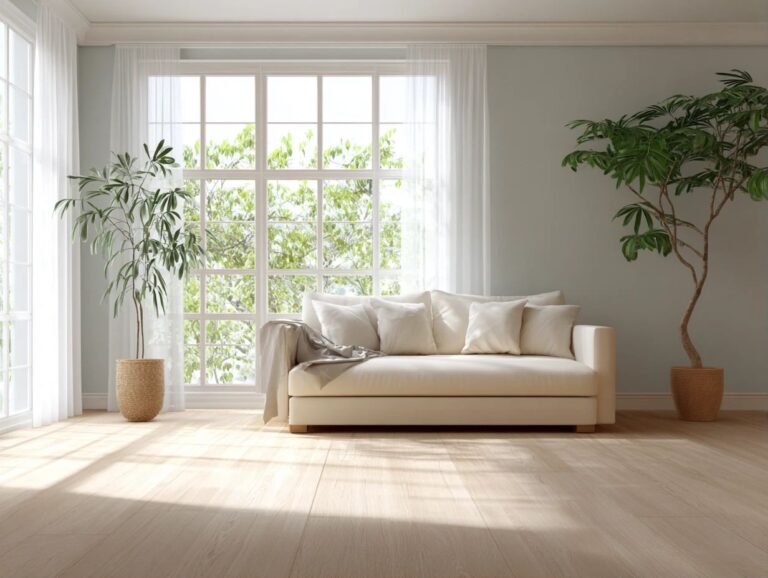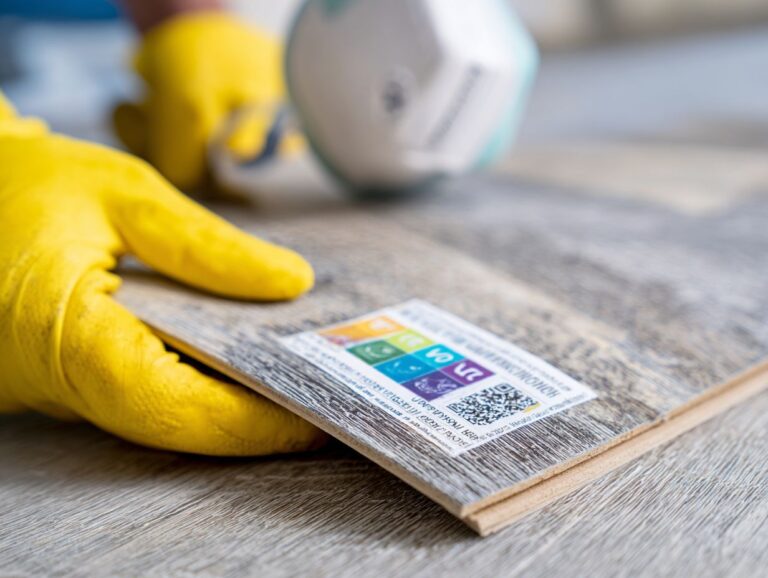Flooring Transitions Between Rooms – Professional Solutions
Flooring transitions between rooms are essential for creating a seamless look in your home, especially when using hardwood floors. From T-molding to reducer strips, picking the right transition strips can improve both appearance and utility. In this article, we’ll look at professional methods for making smooth flooring transitions. We will address typical problems and provide expert advice to achieve a perfect finish. Change your space to achieve a smooth look and a unified design in every part of your home.
Key Takeaways:
Contents
- Flooring Industry and Transition Statistics
- Types of Flooring Transitions
- Choosing the Right Transition
- Installation Techniques
- Professional Solutions for Flooring Transitions
- Maintenance of Flooring Transitions
- Frequently Asked Questions
- What are flooring transitions between rooms?
- Why are professional solutions necessary for flooring transitions between rooms?
- What are some common types of flooring transitions between rooms?
- Can flooring transitions between rooms be customized?
- What are the benefits of using professional solutions for flooring transitions between rooms?
- How do I choose the right professional for my flooring transitions between rooms?
Importance of Flooring Transitions
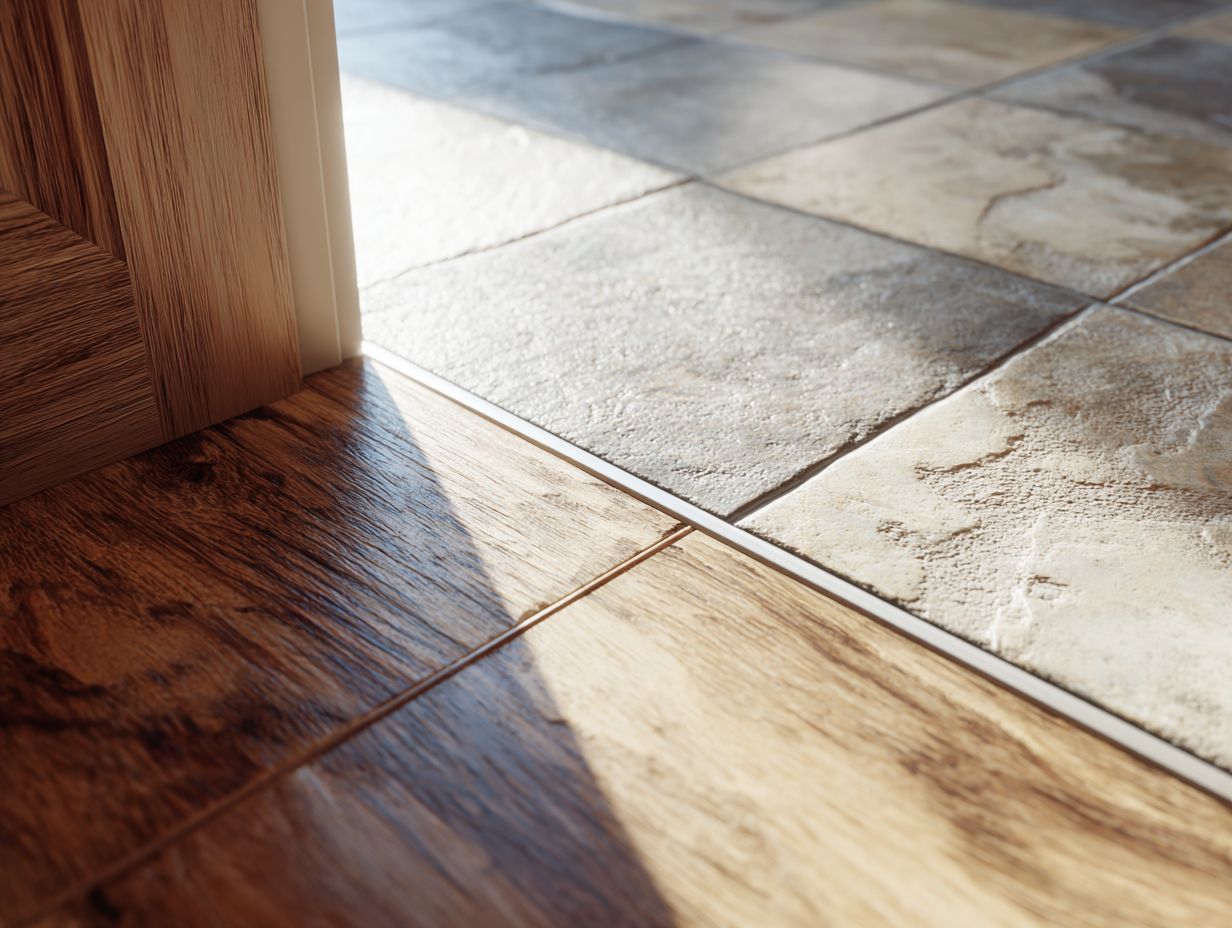
Proper flooring transitions are important because they provide a smooth connection between different types of floors, improving the look of your interior design.
They help stop people from tripping and keep the design together. Using T-molding where wood connects with tile creates a smooth transition and shields the edges from damage.
Similarly, a quarter round can help conceal gaps while contributing an attractive finish. Consider using heavier transition strips in high-traffic areas for added durability.
Picking the appropriate color and material for these transitions can improve your design, creating a smooth connection between different flooring elements.
Flooring Industry and Transition Statistics
Flooring Industry and Transition Statistics
Flooring Market Growth: Market Sizes and Sales
Flooring Market Growth: Flooring Sector Growth Rates
Flooring Market Growth: Price Ranges
The Flooring Industry and Transition Statistics give a detailed view of the present situation and expected expansion of the worldwide flooring market, concentrating on market sizes, growth speeds, and pricing patterns. This information is important for people in the industry, such as manufacturers, retailers, and consumers. It points out potential benefits and difficulties in this changing sector.
The data indicates that the flooring market is experiencing substantial growth. The global flooring market in 2020 was valued at $388 billion and is expected to rise significantly to $621.54 billion by 2028. This rise indicates a strong need due to city growth, new housing, and remodeling projects. Additionally, the reported $12 billion in revenue from U.S. carpet sales reflects a strong domestic market for this flooring type.
- The annual global floors sold figure of 450 billion Square feet show the large size and scope of this industry, emphasizing the need for effective production and distribution systems to satisfy international demand.
Examining sector growth rates, the data reveals a 7.4% Compound Annual Growth Rate (CAGR) for vinyl flooring, the highest among flooring types. This growth is driven by vinyl’s affordability, durability, and versatility. Meanwhile, wood and laminate flooring also see notable growth with a 5.3% CAGR, emphasizing consumer interest in natural aesthetics and sustainable options.
- In North America, the wood flooring segment grows at a slower rate of 1.5% CAGR, possibly due to market saturation or competition from alternative materials.
- The carpet industry experiences a 4.6% CAGR, indicating steady demand, perhaps driven by its comfort and acoustic properties.
On the topic of price ranges, the costs associated with flooring installations vary widely. Carpet installation costs range from $800 to $2600, depending on factors like material quality and project scope. In contrast, floor installation costs per square foot can range from $3 to $22, reflecting the diversity of flooring materials and associated labor costs.
Overall, the Flooring Industry and Transition Statistics Show the market growing with many chances for development in different areas. Main companies in the industry need to change with consumer tastes and new technology to take advantage of these trends and satisfy the increasing worldwide need for flooring products.
Common Challenges in Flooring Transitions
Flooring transitions can have various issues, like differences in height that might cause tripping and moisture problems that impact durability.
To effectively manage height differences, consider using transition strips available in various materials like wood, vinyl, or aluminum.
These strips can create a gradual slope between different floor types, reducing the risk of tripping.
For moisture concerns, install a vapor barrier during the flooring process to protect against water damage, especially in areas prone to humidity, such as basements.
This mix of transition strips and vapor barriers increases safety and extends the lifespan of your flooring.
Types of Flooring Transitions
Different flooring transitions are designed for specific flooring materials and styles, each fulfilling its own function. To create a cohesive look, consider strategies for creating visual flow throughout connected spaces, such as those outlined in our hidden gem on open floor plan flooring.
Thresholds
Thresholds provide a clean finish where two different flooring types meet, offering both aesthetic appeal and functional support.
In hardwood flooring, thresholds are essential for accommodating natural expansion and contraction due to moisture changes, preventing warping and gaps.
For example, using a solid wood threshold in a transition from hardwood to tile helps maintain structural integrity while providing a seamless look. In contrast, vinyl flooring requires a moisture-resistant threshold to mitigate dampness, as it can be susceptible to mildew.
Using thresholds that match your floor style-such as a stained wood threshold for oak hardwood-creates a consistent look in the area.
T-Molding
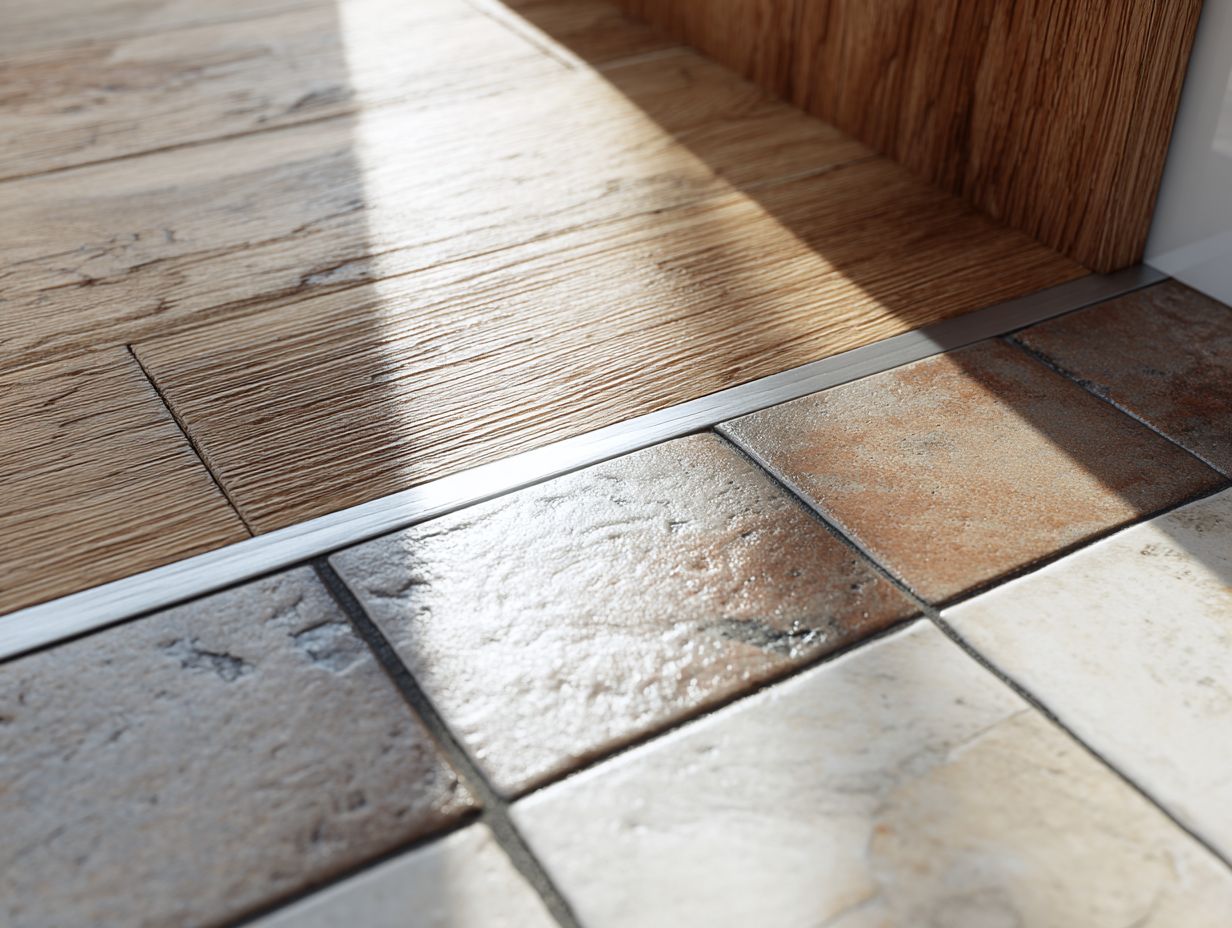
T-molding provides a neat appearance when connecting two floors, especially useful for switching the direction of flooring.
It’s particularly effective when transitioning from hardwood to tile or laminate to carpet, ensuring a seamless look.
- For installation, begin by measuring the gap between floors; the T-molding should ideally fit snugly within it.
- Use a strong glue or screws to hold the molding firmly in place and make sure the edges are smooth to avoid any tripping risks.
- Choosing mold finishes that match your flooring can improve the look a lot, so look for options in wood tones or colors that are similar.
Reducer Strips
Reducer strips are essential for bridging the height difference between two flooring types, ensuring a smooth transition without abrupt changes.
These strips are particularly beneficial when transitioning between hardwood and tile, where height variance can lead to tripping hazards.
To install, begin by measuring the gap and then cut the reducer to the correct size. Apply a strong adhesive or use nails for secure placement.
Consider that in high-traffic areas, metal reducers offer durability, while wood provides a warmer aesthetic.
Always select a reducer that matches your flooring material for a seamless look, and be aware of expansion gaps, ensuring all materials can shift without warping.
End Caps
End caps provide a clean finish to the edge of a row of flooring, making them ideal for areas with different types of flooring.
End caps help create smooth changes between different flooring types, improving appearance and usefulness. They can be used with various materials like laminate, vinyl, or hardwood, ensuring a smooth connection.
For example, when installing laminate flooring next to tile, an aluminum end cap offers a durable, stylish edge while preventing chipping. Consider matching the end cap color to your flooring to create a cohesive look.
When buying, tools like a miter saw for exact cuts and glue for tight fitting can help achieve a professional installation.
Choosing the Right Transition
Picking the best flooring transition requires thinking about different elements like the types of flooring, how it looks, and how long it will last.
Considerations for Different Flooring Types
Different flooring types need particular methods for joining to make sure they fit well and look good together.
For instance, when transitioning from hardwood to tile, consider using a T-molding to create a smooth and durable joint that allows for slight natural expansion.
If you’re moving from laminate to luxury vinyl, a reducer strip is ideal to compensate for the height difference while maintaining a clean appearance.
Meanwhile, when flooring types share similar heights, such as two different laminates, a flush transition can provide a seamless look without additional elevation.
Choosing the correct transition piece improves the look of your space and helps maintain the durability of your flooring.
Matching Aesthetics
It’s important to make sure your flooring transitions match the overall design to create a unified appearance in any area.
To achieve this, consider the following strategies:
- First, choose transition strips that complement your flooring colors; for instance, if you have warm wood tones, opt for similar shades in your transitions.
- Second, match textures-smooth transitions fit well with polished floors, while beveled edges may suit rustic designs.
Tools like a color wheel can help identify harmonious shades. Try out samples to understand how various materials interact before making a choice, ensuring the changes blend well with your overall design style.
Durability and Maintenance
Durability and ease of maintenance are key factors when selecting flooring transitions, impacting long-term performance.
When choosing materials, consider how they will withstand wear and tear. For instance, metal transitions offer superior durability in high-traffic areas, while PVC provides a flexible, moisture-resistant option ideal for bathrooms.
Regular cleaning with a damp cloth and avoiding abrasive cleaners can significantly extend their life. Inspect for damages quarterly; early repairs prevent costly replacements.
Investing in quality transitions, such as Johnsonite or FloorMuffler, can save you money and effort in the long run, ensuring a seamless and attractive transition between different flooring types.
Installation Techniques
Good installation methods are important to make sure flooring transitions work well and look good over time, especially in challenging spaces like RV and camper flooring, where unique materials and techniques are essential for durability and aesthetics.
Preparation of the Subfloor
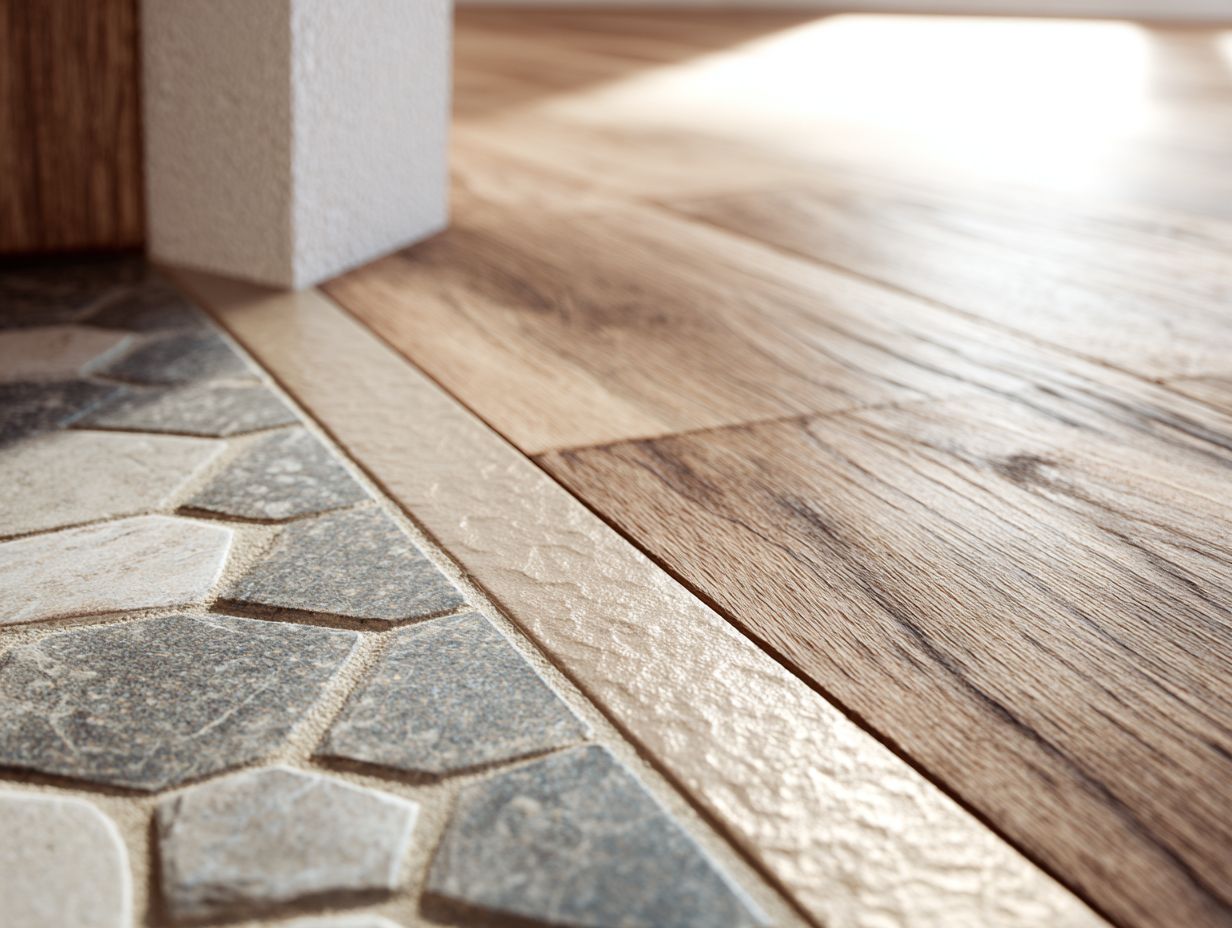
Getting the subfloor ready is important for installing flooring transitions properly, affecting both stability and appearance.
- Start by leveling the subfloor using a high-quality leveling compound to fill in any dips or uneven areas.
- After leveling, perform a moisture test to check if humidity is right; it should be 12% or less. Use a moisture meter to get exact readings.
- Trim any rough edges around the perimeter to create clean transitions and to facilitate easier installation of the new flooring.
This thorough preparation makes your flooring last longer and looks better in your space.
Measuring and Cutting Transitions
Exact measuring and cutting are important for a tidy finish when installing flooring transitions, minimizing gaps and rough edges.
To make exact cuts, begin by measuring the width and height of the area where the change occurs using a laser level or a dependable measuring tape.
For most transitions, a miter saw offers the best results, allowing for clean, angled cuts. Use a square to keep your cuts straight, and confirm measurements before cutting.
If you’re working with vinyl or laminate, consider a utility knife for scoring. Tools like the Everhard Carpet Cutter are effective for adjusting height.
Following these methods will significantly improve your flooring project’s overall appearance.
Securing Transitions in Place
Securing flooring transitions properly is critical to their performance, ensuring longevity and maintaining a clean edge.
To effectively secure flooring transitions, consider using adhesive, nails, or screws depending on your material and environment.
For example, a heavy-duty construction adhesive is ideal for vinyl transitions, providing a flexible bond that withstands movement. In contrast, metal or wood transitions may benefit from screws, offering a sturdy hold, especially in high-traffic areas.
When using nails, make sure they are suitable for the type of flooring and where you are installing them. Always pre-drill to prevent splitting and use finish nails for a cleaner look.
Using these approaches will improve strength and appearance.
Professional Solutions for Flooring Transitions
Hiring experienced workers for challenging installations makes sure flooring changes are done properly, resulting in improved results.
When to Hire a Professional
Hiring an expert can save time and make sure flooring transitions are put in right without overspending.
For example, if your space has complicated designs, like detailed patterns or many angles, a professional’s knowledge will be very helpful.
If you’re working with areas that tend to be damp, like basements or bathrooms, hiring a professional guarantees that moisture barriers and suitable materials are used correctly.
Look for professionals with good reviews and specific experience in flooring transitions. Spending a few hours on consultations can help you make a better choice and achieve a perfect result.
Cost Considerations
Knowing the expenses involved in hiring a professional for flooring transitions can help you plan your project’s budget properly.
When considering professional installation, you might encounter costs ranging from $2 to $5 per linear foot for labor, depending on your location and the complexity of the transition.
Along with labor, factor in materials-transition strips typically cost between $10 and $30 each. For a 20-foot transition, a professional installation could total $100 to $200.
Alternatively, if opting for a DIY approach, you’ll save on labor but will need to invest in tools like a miter saw or a flooring nailer, costing an additional $50 to $150.
Finding the Right Contractor
Choosing the right contractor for flooring transitions is important to achieve good work and meet design goals.
- Start by gathering recommendations from friends or family.
- Check online review platforms like Yelp or Angie’s List for contractors in your area.
- Verify their credentials, including licenses and insurance, as these protect you from potential liabilities.
- Get at least three quotes. Look at the prices, what the work includes, and the expected completion times.
- Don’t hesitate to ask for references and follow up on them to gauge past performance. This thorough vetting process will help secure a reliable contractor who meets your flooring needs.
Maintenance of Flooring Transitions
Paying attention to flooring transitions helps them stay in good shape and work properly over time.
Regular Cleaning Tips
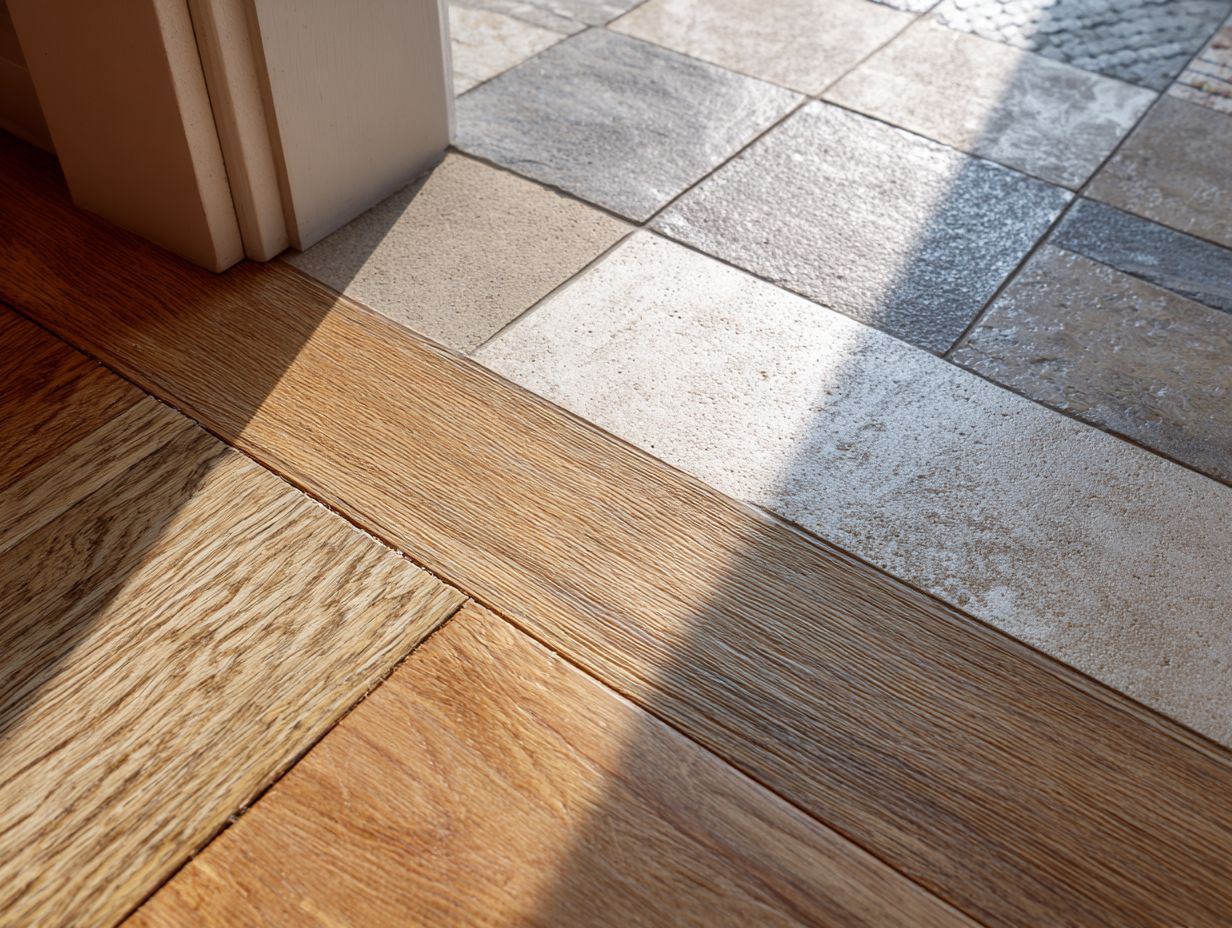
Regular cleaning can prevent the buildup of dirt and grime around flooring transitions, enhancing their durability and visual appeal.
To effectively clean transitions between different flooring types, start by using a soft broom or vacuum with a brush attachment to remove loose dirt.
For hardwood transitions, a damp microfiber cloth with a gentle wood cleaner will remove stains without damaging the finish.
If you’re dealing with tile transitions, a mixture of warm water and vinegar can help break down soap scum.
Rubber or carpet transitions benefit from a light scrub with a carpet cleaner or upholstery brush to sustain their appearance.
Be sure to dry any areas thoroughly after cleaning to prevent moisture damage.
Repairing Damaged Transitions
Fixing damaged floor transitions quickly can stop more problems and keep your floor looking good.
To address damaged transitions, evaluate each situation carefully.
For minor scratches, sanding and refinishing may suffice. If the material is badly twisted or damaged, it usually needs to be replaced.
People who enjoy DIY can use a chisel and glue for simple fixes. For more challenging problems, getting a professional is the best way to have a good result.
It’s essential to match the new transition with the existing floor type-consider using matching materials or finishes to create a seamless appearance.
Quickly fixing these issues can prevent more expensive repairs later.
Final Thoughts on Flooring Transitions
Spending time and money on selecting and putting in the right flooring transitions leads to a smooth and practical design.
- Begin by evaluating your space’s needs, focusing on areas where different flooring types meet. For instance, if you have hardwood transitioning to tile, consider using a T-molding for a seamless transition.
- Another option is a threshold for doorways, which also helps with height differences. Use a measuring tape and a miter saw to make exact cuts.
- Make sure all transitions are firmly in place with glue or nails to help them last longer. Choosing the right transitions improves both the look and function of your design, so spend time finding what works best.
Frequently Asked Questions
What are flooring transitions between rooms?
Flooring transitions between rooms are the strips of material used to connect two different types of flooring in adjacent rooms. They are used to create a smooth and seamless transition between floors and can also serve as a decorative element in a space.
Why are professional solutions necessary for flooring transitions between rooms?
Expert solutions for flooring transitions between rooms make sure the transition is done properly and smoothly. This involves using the right materials, methods, and tools to achieve a professional and finished appearance.
What are some common types of flooring transitions between rooms?
Some common types of flooring transitions between rooms include T-molding, threshold, and reducer transitions. T-molding is used for connecting two floors of equal height, while threshold transitions are used for connecting two floors of different heights. Reducer transitions are used for connecting two floors of different materials.
Can flooring transitions between rooms be customized?
Yes, flooring transitions between rooms can be customized to fit your specific needs and design preferences. You can select different materials, colors, and finishes to make a special and custom change between your floors.
What are the benefits of using professional solutions for flooring transitions between rooms?
Using expert options for flooring transitions between rooms guarantees a smooth and visually appealing shift between your floors. It also saves you time and effort, as professionals have the skills and experience to finish the job quickly and well.
How do I choose the right professional for my flooring transitions between rooms?
When choosing a professional for your flooring transitions between rooms, it is important to do your research and check their credentials and experience. You can ask for references and look at their past projects to check if they have the ability to finish the task well.

